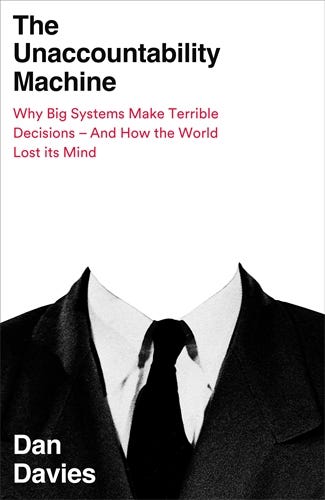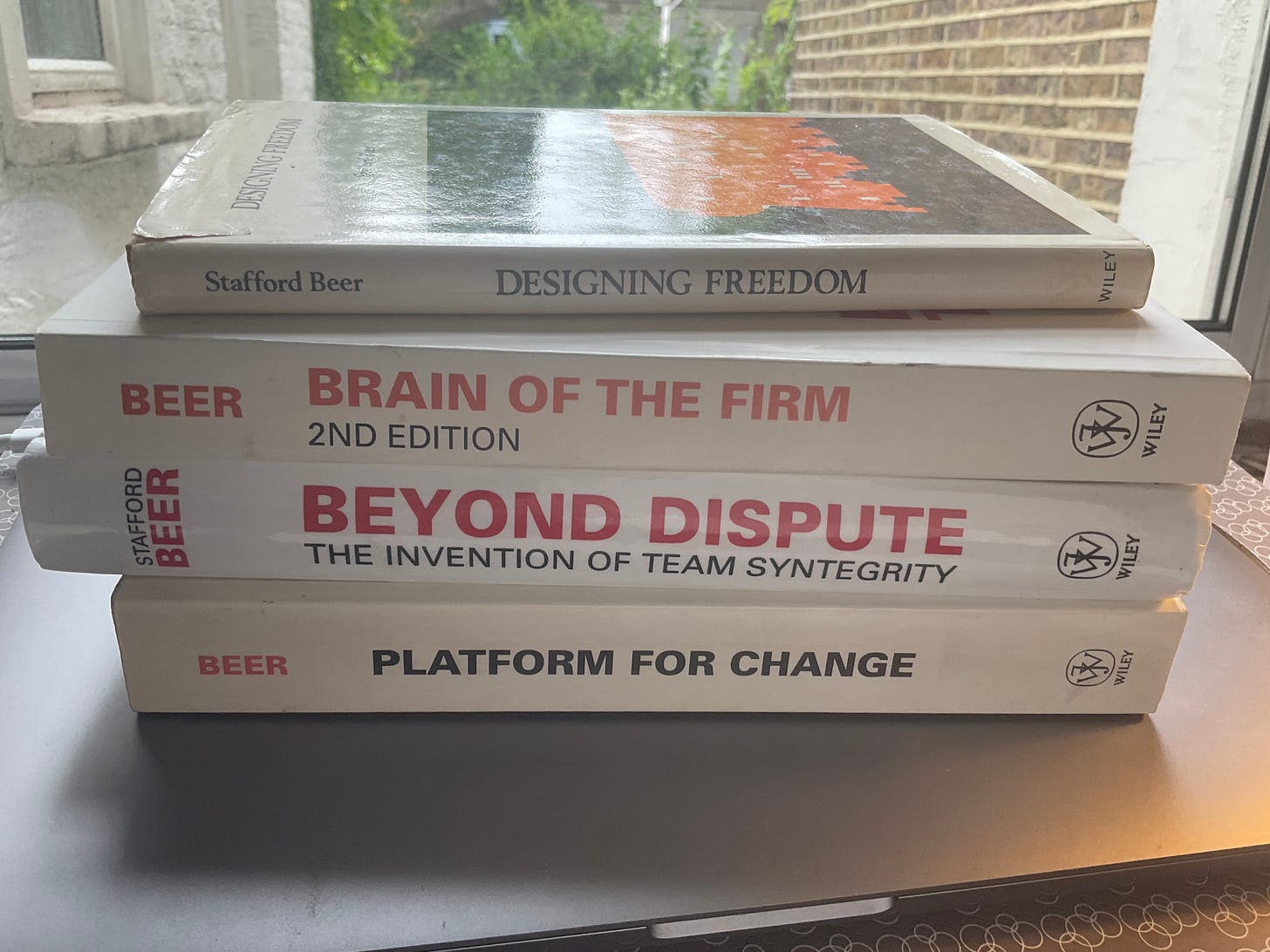Nine chapters into his book The Unaccountability Machine, Dan Davies makes a little self-deprecatory joke. He had intended to write a detective mystery about cybernetics, he says, but has spent eight chapters describing the construction of the murder weapon.
The question that Davies starts out with is about how it is that the modern organisation has become structured in structured in such a way that when bad things happen, to customers, or users, or suppliers, no one can be found to be accountable for these poor outcomes.

(Source: Profile Books)
The computer says no
We’ve all had these experiences: the computer says no.
And worse than this: that the organisations that are supposed to ensure accountability suffer from exactly the same set of problems. Rather than regulating, they end up as mirrors of the organisations they are supposed to regulate.
The journey to answering this question takes him in two directions. The first is the world of management cybernetics, in the period from the 1950s to the 1970s, and in particular the work of Stafford Beer developing his Viable System Model.
The second is in the development of the “shareholder value” model of the corporation, based on the initial work of Milton Friedman, and some of the ways in which neo-classical economics has failed as a model of the world while becoming immensely influential for policy makers.
Two revolutions
These seem like divergent routes, but they are connected by an observation he makes early in the book:
The way in which the economics profession ignored most of the work done in information theory is striking. (p.6)
He contrasts these as the story of two revolutions: on the one hand, a management revolution, which transferred power to managers and investors; and on the other, a “cybernetic revolution, which looked as if it was going somewhere interesting but never arrived.”
Since this review is going to be long, I’m going to split these into two, starting with the cybernetics.
I’m pleased that Davies has set out to write a book about this because I have wondered from time to time, since I first came across Stafford Beer’s work in the 1990s, why the underlying models, notably the Viable System Model, that he and colleagues developed haven’t had more impact on organisations.
Cybernetic thinking
Management cybernetics was not just an academic subject. Beer had come through the ranks of British management, and the models and tools that emerged from management cybernetics were tried out in actual organisations, both those that he worked for and, later, those that he advised.
So perhaps the best place to start is with the mental models that underpin cybernetic thinking about organisations. There is a small number of essential underlying building blocks. These can be summarised as: “the black box”; POSIWID (“the purpose of a system is what it does”; and the law of requisite variety.
The first of these is about the behaviour of a complex system. Often you can’t tell what a complex system is doing, and trying to take it apart (as if it is, instead, a complicated system) will not help you. Therefore you have to treat it as a black box. You know what the inputs are and you know what the outputs are, even if you don’t know what happens between those two points.
Corporations, systems and purpose
These leads to the second building block, that the purpose of a system is what it does.
Because you don’t know what’s going on inside the black box, you need to assume that the system is designed to produce the outcomes it produces, even if those are not what those in charge of it say they are doing. Looking back at a recent piece on my Just Two Things newsletter about the pharma industry and drugs through this lens, the purpose of the US pharma sector is to extract the highest possible prices for drugs from the health market, regardless of the overall public health outcome.
There is a significant benefit to this, of course. You can simply discount the flannel and doorknob polishing you get from Chief Executives and their boards about their corporate purpose, and look at what they actually do.
Matching ‘variety’
The third element here is the law of requisite variety, developed by Ross Ashby. This states—and is mathematically provable, if not by me—that a viable organisation needs to match the ‘variety’ in its external environment with its variety internally. Think of ‘variety’ as complexity. It does this in two ways: by attenuating (reducing or removing) information from the external environment, and by amplifying its internal ability to understand what is happening in its external environment:
You are always attenuating variety in some way or another, unless you are describing a system that consists of everything in the universe. The simple act of drawing the black box is a form of attenuation. (p108)
From these building blocks, Stafford Beer constructed the “Viable System Model”, a cybernetic model of the components of a viable organisation and the information flows between them.2 I have tried to apply this model in the past, from Beer’s own writing in The Brain of the Firm and Diagnosing the System for Organisations, but it is slow going.

(Photo: Andrew Curry. CC SA-NC 4.0)
The five systems
Trying to keep this as simple as possible, there are five systems in the viable system model.
System One is the part of the system that does things: it makes things, it produces things, it despatches things, it sells things.
System Two co-ordinates things: it prevents clashes between different parts of the operations in System One.
System Three optimises the decisions about what to do today to achieve a purpose—the “here and now”, as Davies summarises it.
System Four monitors how the external environment is changing—it looks out and it looks forwards at “those parts of the environment that aren’t in direct contact with System One”. Or: “the not here, not yet”.
And System Five is about philosophy, purpose and identity—“understanding that identity, philosophy and purpose are tools of information management.” (p125)
Informal channels
Visually, this looks like two triangles sitting on top of each other. System Two and System Three are talking both to each other and to System One, and there can be some confusion between System Two and System Three from time to time. In fact effective organisations typically ensure good informal channels between System Two and System Three.
And System Three and System Four are talking both to each other and to System One. So System Three acts as a kind of pivot between the day to day business of the organisation, and its prospects and its purpose.
When information counts
Davies summarises the key elements of all of this in three reasonably crisp sentences:
- There are five core functions, and if any of them are missing or under-resourced, the flow of information won’t be balanced with the capacity to process it.
- Information only counts if it’s being delivered in a form in which it can be translated into action, and this means that it needs to arrive quickly enough.
- Systems preserve their viability by dealing with problems as much as possible at the same level at which they arrive, but they also need to have communication channels that cross multiple levels of management, to deal with big shocks that require immediate change. (p132-133)
In setting out to explain management cybernetics, Davies brings some virtues. He is a clear writer himself, and wants to apply the model rather than just understand it. His explanations are good. And he acts as a critical friend here: he mocks, gently, Beer’s penchant for both complex diagrams and for inventing jargon, while also using accessible examples both of how the elements of the viable system fit together, and how systems that turn out not to be viable fell apart.

(Dan Davies: Source: Hachette Australia)
The orchestra as a viable system
The accessible example of the VSM that he offers is the orchestra. System 1 is the musicians, but also operational functions like bookings and transport; System 2 is the score or the charts, and it is also the conductor’s timekeeping function; System 3 is the conductor’s feedback to the orchestra (quieter, louder, more attack, and so on).
System Four is about the future trends that might shape the repertoire and personnel—for example including more works by women or other composers of colour.
And System Five might be about an approach to its music: the Aurora Orchestra, for example, believes that “orchestral music is for everyone”, and so it creates “musical experiences beyond the ordinary”—for example playing without scores to bring greater freshness to familiar pieces.
Non-viable systems
That’s all very good, but it’s more interesting when it’s used to analyse systems that have become non-viable. Davies uses the global financial crisis as an example. The central banks weren’t paying enough attention to the debt bubble, and they had weakened communications systems to senior policy makers.
The information was there, but it hadn’t been organised into an information framework. There was
”no shortage of warnings, but none in a form that could be recognised as requiring action.” (p135)
What happens in these situations is that something in the external environment manages the situation instead. Davies uses the analogy of the “red handle”, pulled on trains in response to a driver identifying an emergency. In the case of the financial crisis, the collapse of Lehmann Brothers was the ‘red handle’ event.
Weather shocks
In the case of the climate emergency, POSIWYD tells is that the purpose of the system is to increase emissions. System Four is vastly underdeveloped compared to Systems Two and Systems Three. And System Five is still, primarily, about economic growth. The red handle event is the extreme weather events that are creating repeated shocks and destabilising the insurance market and potentially other parts of the financial system.
One of the implications of all of this is that organisational outcomes and systems outcomes are what they are. If you want to change them (e.g. to make the transport or food system less dependent on fossil fuels), you need to change the purpose of the system. That’s harder, of course, but it offers more clarity.
(A second part, looking at organisations and economics will follow in the near future.)
Want to read more?
- ‘Making communities work’, Just Two Things, 13 June 2022.
- ‘Cybernetics and the science of managing our crisis’. Just Two Things, 20 April 2024.
—-
A version of this article is also published on my Just Two Things Newsletter.
